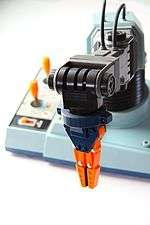Armatron
The Armatron is a toy robot which was made by TOMY and distributed by Radio Shack in the United States since 1984.[1] It consists of a crane-like arm which picks up small objects by the user manipulating two attached joysticks. Its shape resembles industrial robots of the 1980s, though it is strictly user-controlled, with no automation built in. The arm has six degrees of freedom: wrist rotation (unlimited), vertical wrist flexing, horizontal elbow bending, shoulder horizontal rotation (unlimited), shoulder elevation, and the opening (releasing) and closing (grasping) of the two-fingered end-effector.


Included with the original Radio Shack Armatron was a module pack of items to be lifted and moved. The pack consists of two stepped cones, two spheres, two cylinders, a flat base module, and a hinged lidded box module, all made of plastic; the modules have molded positions for the six objects (with the spheres resting on top of the cones when they are on the box module). The user is challenged to use the arm to move the spheres and cones from the top of the box to their positions on the flat module, open the lid of the box, and then remove the cylinders from the box and place them in position on the flat module. It is possible, but not easy, to do all of this with the arm alone. The Armatron includes an "energy level" indicator, actually a countdown timer, above the joysticks; this can be set by the user to an initial level from 1 to 10 "energy" units--actually uncalibrated time units--and it will shut off the arm when the set time runs out. Thus, the challenge is not only to move the objects, but to do it in limited time. Once a player can complete a manipulation task with the arm in a certain amount of time, the player can reattempt the same task with a shorter time limit, giving the game replay value.
Models with alternate decals or coloring were marketed under slightly different names, including the Super Armatron and the Armatron II. The original stationary version was succeeded by a mobile version with a wired remote.
The arm is almost purely mechanical; it has no electronic components, and the only electrical components are the DC motor, switch contacts in the countdown timer, on/off switch, and of course the batteries. The two joysticks selectively engage or disengage gears on a set of rotating drums to control the arm's movement. Because the "energy level" timer is driven off the ordinary DC motor, it is not very accurate, as it will run more slowly as the batteries run down and cause the motor speed to decrease; however, this has the fair compensating effect of giving the player more time as the arm moves more slowly.
See also
References
- Hawkins, William J. (1984-03-01). "What's new in Electronics". Popular Science.
External links
| Wikimedia Commons has media related to Armatron. |